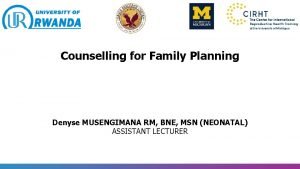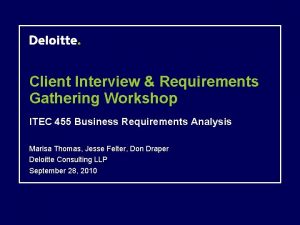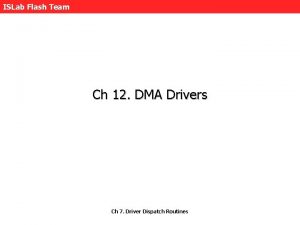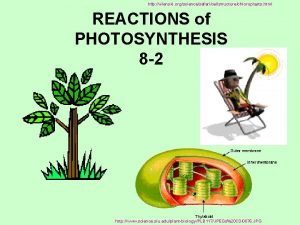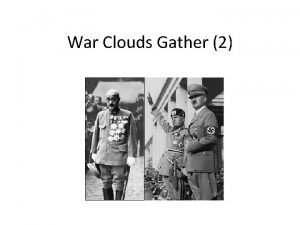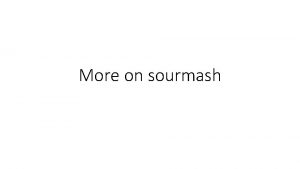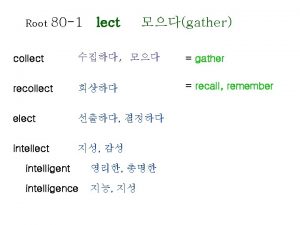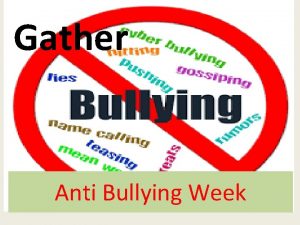How to gather DATA Process of statistics 1












- Slides: 12

How to gather DATA

Process of statistics 1) Identify the research objective - Create a detailed question to a specific group that is to be answered. 2) Collect the information needed to answer the question. 3) Organize and summarize the data. 4) Draw conclusions from the information and generalize it to the population. 2

Surveys • Statistical surveys collect quantitative information from a specific population. • A survey may focus on opinions or factual information. • Surveys may involve answering a questionnaire or being interviewed by a researcher.

SURVEY Advantages of surveys: Disadvantages of surveys: • can be administered in a variety of forms (telephone, mail, on-line, mall interview, etc. ) • are efficient for collecting data from a large population • can be designed to focus only on the needed response questions • are applicable to a wide range of topics • are dependent upon the respondent's honesty and motivation when answering • can be flawed by non-response • can possess questions or answer choices that may be interpreted differently by different respondents (such as the choice "agree slightly")

How will data be collected? • Include the entire population • Simple Random Sample – number generated (equal chance of selection) • Stratified Sampling – broken into groups and then random sampled • Systematic Sampling – is obtained by selecting the k th individual from population • Cluster Sampling – is obtained by selecting all individuals within a collection or group 5

Experimental study • The researcher takes measurements, or surveys, the sample population. • The researcher then manipulates the sample population in some manner. • After the manipulation, the researcher remeasures, or re-surveys, using the same procedures to determine if the manipulation possibly changed the measurements. • During a "controlled" experiment, the researcher will separate the sample population into groups with one group established as the control group.

Experimental Study Example • A group of students is interested in knowing if the number of times they can sink a basketball is related to the color of the basketball. The students shoot a series of baskets and record their success using a regulation colored basketball. They then switch to a blue colored basketball and shoot the same series of baskets. A statistical analysis is performed.

Observational Study • The sample population being studied is measured, or surveyed, as it is. • The researcher does not influence the population in any way or attempt to intervene in the study. • There is no experimental manipulation. Instead, data is simply gathered and correlations are investigated.

Observational Study Example • A group of students is interested in knowing if there is a correlation between attending an SAT Prep class and scores achieved on the SAT Examination. The students use a survey to collect their data from both students who took an SAT Prep class and those that did not take an SAT Prep class. A statistical analysis is performed.

Biased Sample • Who collected the data? Does the group collecting the data have an interest in how the results turn out? • Example: A study on the hazards of cigarette smoking being done by a tobacco company. (may not be reliable findings - conflict of interest) • Is the study a recent study, or did it occur decades ago? Could recent developments have changed the findings? • Example: Decades past, second-hand cigarette smoke was found to not be hazardous. More recent findings prove that this is not true. (findings should be current)

Biased Sample Con’t • What is the sample size of the study? How many people/items were studied? • Example: A study is done on the favorite color of 14 year olds. The sample group for the study is Mrs. Smith's third period class containing 20 students. (too few participants to generalize a finding to all 14 year olds) • Is the data from a primary source? Or has the data been "condensed" by another group? • Example: The US Census Bureau collects data on US populations. A tabloid magazine publishes a synopsis of the findings. (the most reliable information comes from the original source - avoid the "Reader's Digest" condensed version by another publisher who may be interpreting the findings)

Applying what we have learned: • What is the average distance of a HS student’s house to Newfane High School? • How will we collect this information? – Survey each student? – Map. Quest everybody? – Internet polling? • Not reliable! – Take a sample of the population? A random sample • How will we organize this data? – Charts, graphs, tables? • Is there any Bias or Flaws with this study? 12
 Introduction to statistics what is statistics
Introduction to statistics what is statistics How do journalists gather information
How do journalists gather information Keep on believing god will answer prayer lyrics
Keep on believing god will answer prayer lyrics Cubing can help you gather details about a topic by
Cubing can help you gather details about a topic by Gather in family planning
Gather in family planning Requirements gathering workshop agenda
Requirements gathering workshop agenda Gather acronym in counselling
Gather acronym in counselling Gather ye roses while ye may
Gather ye roses while ye may Gather the people
Gather the people Scatter gather dma
Scatter gather dma Plants gather energy with light-absorbing pigments called *
Plants gather energy with light-absorbing pigments called * Stalin tower
Stalin tower People gather to worship
People gather to worship




